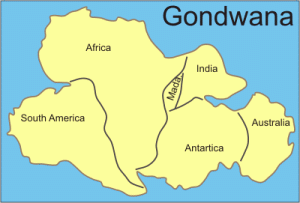Introduction
Gondwana - a Historical Perspective
The name "Gondwana" was proposed in 1872 by Medlicott from the ancient kingdom of the Gonds, one of the principal aboriginal tribes believed to have inhabited a large part of central India in which the most complete sequence of these strata is found (www.searchanddiscovery.net/documents/97019/index.htm).
This original type section of Gondwana strata forms a more or less continuous sequence from upper Carboniferous to Early Cretaceous. An unusual and distinctive fossil plant - Glossopteris - characterizes these sediments. Studies of the fossils and the character of the sediments have shown the existence of similar formations in Africa, South America, Antarctica, Australia, Madagascar and other areas, all of which contain comparable flora and fauna. It is now possible to correlate these successions, beginning in the late Paleozoic and continuing well into the Mesozoic, in now widely separated areas. An Austrian geologist (Eduard Suess) explained these observations in 1885 by stressing the past unity of three continental masses within a supercontinent.
Thirty years later, the German scientist Alfred Wegener extended Suess' concept to include Australia and Antarctica, after Glossopteris had been discovered by Wilson and Bowers during Scott's 1910-1913 Antarctic Expedition. The early works referred to the supercontinent as Gondwanaland; today earth scientists prefer the name Gondwana (www.madsci.org/posts/ archives/2002-12/1041357546.Bt.r.html).
Concept of Gondwana
Gondwana is an assemblage of different continents, Africa, South America, Australia, Antarctica and India. Its complex geological history includes the creation of the initial cratons during the Precambrian, their amalgamation mainly during the Proterozoic, basin development during the Paleozoic and unification with the northern continents during formation of Pangea, and finally the break-up of Pangea and Gondwana during the Mesozoic. So the today-separated above-mentioned continents share common features such as fossils, similar sedimentary stratigraphy, and the shape of the continents.
